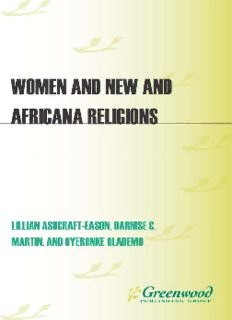
Women and New and Africana Religions (Women and Religion in the World) PDF
Preview Women and New and Africana Religions (Women and Religion in the World)
Women and New and Africana Religions Women and New and Africana Religions LILLIAN ASHCRAFT-EASON, DARNISE C. MARTIN, AND OYERONKE OLADEMO, EDITORS WomenandReligionintheWorld CherylA.Kirk-Duggan,LillianAshcraft-Eason, andKarenJoTorjesen,SeriesEditors P RAEGER An Imprint of ABC-CLIO, LLC Copyright2010byLillianAshcraft-Eason,DarniseC.Martin,andOyeronkeOlademo Allrightsreserved.Nopartofthispublicationmaybereproduced,storedina retrievalsystem,ortransmitted,inanyformorbyanymeans,electronic,mechanical, photocopying,recording,orotherwise,exceptfortheinclusionofbriefquotationsina review,withoutpriorpermissioninwritingfromthepublisher. LibraryofCongressCataloging-in-PublicationData WomenandnewandAfricanareligions/LillianAshcraft-Eason,DarniseC.Martin,and OyeronkeOlademo,editors. p.cm.—(Womenandreligionintheworld) Includesbibliographicalreferencesandindex. ISBN978–0–275–99156–2(hardcover:alk.paper)—ISBN978–0–313–08272–6(ebook) 1. Women—Religiouslife.2. Womenandreligion. I.Ashcraft-Eason,Lillian.II.Martin,Darnise C.III.Olademo,Oyeronke. BL625.7.W627 2010 299.6082—dc222009020760 14 13 12 11 10 1 2 3 4 5 ThisbookisalsoavailableontheWorldWideWebasaneBook. Visitwww.abc-clio.comfordetails. ABC-CLIO,LLC 130CremonaDrive,P.O.Box1911 SantaBarbara,California93116-1911 Thisbookisprintedonacid-freepaper ManufacturedintheUnitedStatesofAmerica Contents Introduction—LillianAshcraft-Eason, DarniseC.Martin,andOyeronkeOlademo vii PARTI.WOMEN,FAMILY,ANDENVIRONMENT 1.‘‘ThatGirlIsPoison’’:WhiteSupremacy,Anxiety,and theConflationofWomenandFoodintheNationofIslam 3 StephenC.FinleyandMargaritaL.Simon 2.Receiving,Embodying,andSharing‘‘DivineWisdom’’: WomenintheNationofGodsandEarths 29 FeliciaM.Miyakawa PARTII.SOCIOECONOMICS,POLITICS,ANDAUTHORITY 3.TheLivingShrine:LifeandMeaninginOyotunji 55 YeyefiniEfunbolade 4.Vodou:AHeritageofPower 75 SusheelBibbs PARTIII.MIND,BODY,ANDSPIRIT 5.ServingtheSpirits,HealingthePerson:Womenin Afro-BrazilianReligions 101 KellyE.Hayes 6.SacredDance-Drumming:ReciprocationandContention withinAfricanBeliefSystemsintheSanFrancisco-Oakland BayArea 123 HalifuOsumare v vi CONTENTS PARTIV.SEXUALITY,POWER,ANDVULNERABILITY 7.ToHaveandtoHold:PossessionPerformanceinAfro-Cuban RegladeOcha 145 KatherineJohannaHagedorn 8.AfricanDescendentWomenandReligion:DiasporainOriente Cuba 167 JualynneE.Dodson 9.ReligionandWomen’sSexualityinAfrica:TheIntersectionofPower andVulnerability 191 OyeronkeOlademo PARTV.WOMEN,WORLDVIEW,ANDRELIGIOUS PRACTICE 10.AReligionoftheInterstices:AsianPacificAmericanWomenand MultipleReligiousPractices 207 TracySayukiTiemeier 11.Diana’sGrove:AnEmergent,IntegrativeSpiritual Movement 231 SusanE.Hill,JohnK.Simmons,andCyntheaJones 12.TheGoodWife:TheReligiousExperienceofWomenin Scientology 255 DawnL.Hutchinson 13.SensesofPlace:WomenGreeningCommunities 277 KimberlyWhitney 14.AfricanWomeninTraditionalReligions:Illustrations fromKenya 301 MaryNyangwesoWangila SuggestedReading 323 AbouttheEditorsandContributors 327 Index 333 Introduction Lillian Ashcraft-Eason, Darnise C. Martin, and Oyeronke Olademo T his volume provides insight into the experiences of contemporary womeninNewReligionsandAfricanaReligionsselectedfromdiverse parts of the world. The Africana Religions are categorized as Creole andAfricanIndigenous—thelatterofwhichsometimesisusedinterchange- ably withAfricanTraditionalReligions. The five-partthematicorganization ofthechaptersin this volumeplacestheNew,Creole,and AfricanIndige- nousReligionsinacontextofreligiousandculturaldiversitythatmighthave beenlosthadweincorporatedthemintoavolumeofmoremainstreamreli- gions. Unless one had the opportunity to read all of the volumes in this series,thevarietyandnumberofNewandAfricanasystemsofbelief,theol- ogy,practice,andritualmightnotbeaccessibleorappreciated.Thus,avol- umededicatedtoNewandAfricanaReligionsseemsfittingforourpurpose of increasing awareness of women and religious diversity. Consequently, we give space and voice tothesereligions and, in particular, tothe women whoaffirmthem. Someofthesetraditionsdevelopedinthenineteenthandtwentiethcen- turies,andsocanbeclearlycategorizedasfallingwithintheNewReligions Movement. Others, particularly the Creole Religions, are actually syncre- tized versions from older African Indigenous and other systems; some of these religions date back as far as the sixteenth century. We include these because their emergence has brought something new tothe American cul- turalcontextsinwhichtheywereformed.TheAfricanIndigenousReligions emerged with the autochthenes—the cultural self-starters in Africa—and vii viii INTRODUCTION aresoancientthattheiroriginsonlycanbeapproximatedashavingoccurred in the Primeval Era, evolving over millennia into the institutions that we knowtoday.Thus,thisbroadtimeframeseemstobeareasonableoneforsit- uatingtheforegoingchaptersonNewReligionsandAfricanaReligions. NEW RELIGIONS There are obvious issues associated with the New Religions concept. Questions areraisedthatrequirethoughtfulresponses:Whatorwhodeter- mines that a religion is new, and new in relation to what? Does new mean less legitimate in some way? Are these religions understood to be marginal inrelationtothemoremainstreamorestablishedtraditionsbytheirliterary location? TheNewReligiousMovement(NRM)referstoagenreofreligionsthat isnoveltoaphysicalandculturalenvironmentandthatpresents,intheface of the‘‘old’’orestablishedreligiousinstitutions,unfamiliardoctrines,styles of worship, or ways of life. Many scholars are at work in this area, as evi- denced by the body of scholarship on New Religions, including academic journalsdedicatedtothissubjectanditsformalpresenceasaprogram unit attheAnnualMeetingsoftheAmericanAcademyofReligionandtheSoci- etyofBiblicalLiterature. We, too—as religion scholars and editors of this volume—seek to pro- videplace,context,andunderstandingregardingreligionsthatmightother- wiseremainintheshadowyundersideofreligiousstudies.Whiledefininga religion or set of religions is tenuous, J. Gordon Melton’s description of New Religions is helpful, both in thinking about their nature and in deter- miningparameters:‘‘NewReligionsarethose...thathavebeenfound,from theperspectiveofthedominantreligiouscommunities,...tobenotjustdif- ferent,but[sometimes]unacceptablydifferent.’’1Itisgenerallythecasethat NewReligionsexistin‘‘contestedspaces.’’2Theaptnessofthesedescriptions isborneoutinthenarrativesofchaptersontheNationofIslam,theNation ofGodsandEarths,themultiplereligiouspracticesofAsianPacificAmeri- can Women, the Diana’s Grove spiritual movement, Scientology, and the greeningcommunities. AFRICANA RELIGIONS WehaveappropriatedthetermAfricanaReligionstorefertobothCre- oleReligions(i.e.,AfricanreligionstransplantedtotheAmericasbyenslaved Africans and African religions recently reclaimed and practiced by African Americans) and AfricanIndigenous Religions. ThetermAfricanaencapsu- lates the plurality and uniqueness of the Afro- (Continental African Introduction ix andDiasporanAmerican)religiousexperiences.Thus,wechosetouseAfri- cana in the titleof this volume inordertoaffirmthe pluralitythatAfricana connotes. CREOLE RELIGIONS Fortheconvenience ofsituatingchaptersin thisvolume,by Creolewe meanreligionsthatemergedintheAmericas.Theseareinnovativeandsyn- creticvariants ofAfricanIndigenousReligionsintermingledwithChristian, Amerindian, Islamic, and other conventions and folkloric practices. These CreoleReligionspresentafar-flungmulticulturaltapestry. Margarite Fernandez Olmos and Lizabeth Paravisini-Gebert have inferredtheessenceoftheracial,social,andpoliticalsignificancesofthese religions in their book, Creole Religions of the Caribbean: An Introduction fromVodouandSanteriatoObeahandEspiritismo(Religion,Race,andEth- nicity).3 Moving beyond the geographical boundaries that conventionally defined these religions, we embrace the religious syncretism and multicul- turalism in Creole Religions that have emerged throughout the Americas. Chapters on life and meaning in Oyotunji, empowerment in Vodou, Afro- Brazilian Religions, sacred dance and African belief in the San Francisco- Oakland Bay Area, Afro-Cuban Regla de Ocha, and African Diasporan ReligionsinOrienteCubaexplorefaithsthatarerepresentativeofthemulti- cultural,Creoletraditions. AFRICAN INDIGENOUS RELIGIONS From a geographical perspective, the Indigenous Religions of the Afri- cans have received many labels over the years from African and non- African scholars alike. The chosen nomenclature by any scholar is largely informedbyperspective.Whereassomescholarsdescribethesereligionsas ‘‘African Traditional Religions’’4 and African Indigenous Religions, these referencesmaybeusedinterchangeablyandsomeusethesimpletitle‘‘Afri- canReligions.’’5 AfricanIndigenousReligionsaretheearliestculturalexpressionsofthe diverse and original peoples of the continent. They fall under a variety of names that suggest indigenous ethic groupings: Akan, Nupe, Ewe, Luo, Gambia,andYorubareligions.Thesearedistinguishedfromcolonizingreli- gions,likeChristianityandIslam,thathavenowbeensuccessfullydomesti- cated by Africans. Even though African Indigenous Religions have been affected by change, there is still the possibility of setting them apart from thecolonizing religions. However, thepossibility of demarcatingthesereli- gions does not preclude the mutual influence of practices and cultures.
Description: